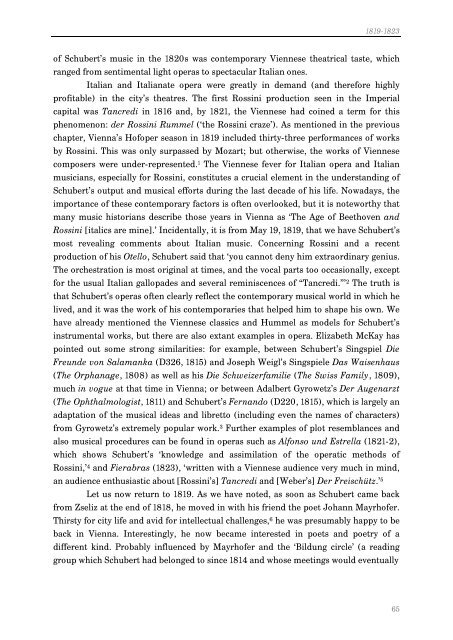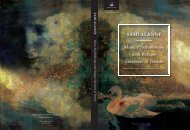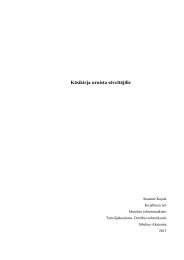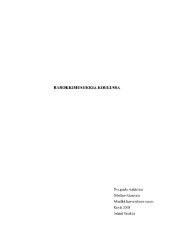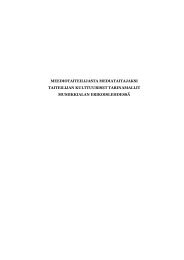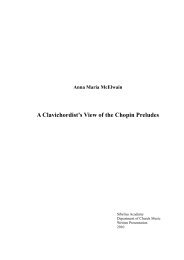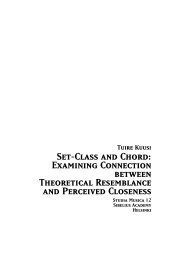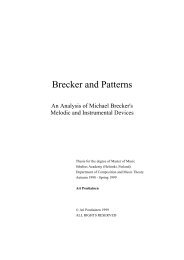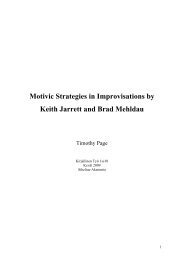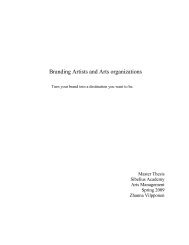The Unfinished Piano Sonatas of Franz Schubert Javier ... - Ethesis
The Unfinished Piano Sonatas of Franz Schubert Javier ... - Ethesis
The Unfinished Piano Sonatas of Franz Schubert Javier ... - Ethesis
Create successful ePaper yourself
Turn your PDF publications into a flip-book with our unique Google optimized e-Paper software.
1819-1823<br />
<strong>of</strong> <strong>Schubert</strong>’s music in the 1820s was contemporary Viennese theatrical taste, which<br />
ranged from sentimental light operas to spectacular Italian ones.<br />
Italian and Italianate opera were greatly in demand (and therefore highly<br />
pr<strong>of</strong>itable) in the city’s theatres. <strong>The</strong> first Rossini production seen in the Imperial<br />
capital was Tancredi in 1816 and, by 1821, the Viennese had coined a term for this<br />
phenomenon: der Rossini Rummel (‘the Rossini craze’). As mentioned in the previous<br />
chapter, Vienna’s H<strong>of</strong>oper season in 1819 included thirty-three performances <strong>of</strong> works<br />
by Rossini. This was only surpassed by Mozart; but otherwise, the works <strong>of</strong> Viennese<br />
composers were under-represented. 1 <strong>The</strong> Viennese fever for Italian opera and Italian<br />
musicians, especially for Rossini, constitutes a crucial element in the understanding <strong>of</strong><br />
<strong>Schubert</strong>’s output and musical efforts during the last decade <strong>of</strong> his life. Nowadays, the<br />
importance <strong>of</strong> these contemporary factors is <strong>of</strong>ten overlooked, but it is noteworthy that<br />
many music historians describe those years in Vienna as ‘<strong>The</strong> Age <strong>of</strong> Beethoven and<br />
Rossini [italics are mine].’ Incidentally, it is from May 19, 1819, that we have <strong>Schubert</strong>’s<br />
most revealing comments about Italian music. Concerning Rossini and a recent<br />
production <strong>of</strong> his Otello, <strong>Schubert</strong> said that ‘you cannot deny him extraordinary genius.<br />
<strong>The</strong> orchestration is most original at times, and the vocal parts too occasionally, except<br />
for the usual Italian gallopades and several reminiscences <strong>of</strong> “Tancredi.”’ 2 <strong>The</strong> truth is<br />
that <strong>Schubert</strong>’s operas <strong>of</strong>ten clearly reflect the contemporary musical world in which he<br />
lived, and it was the work <strong>of</strong> his contemporaries that helped him to shape his own. We<br />
have already mentioned the Viennese classics and Hummel as models for <strong>Schubert</strong>’s<br />
instrumental works, but there are also extant examples in opera. Elizabeth McKay has<br />
pointed out some strong similarities: for example, between <strong>Schubert</strong>’s Singspiel Die<br />
Freunde von Salamanka (D326, 1815) and Joseph Weigl’s Singspiele Das Waisenhaus<br />
(<strong>The</strong> Orphanage, 1808) as well as his Die Schweizerfamilie (<strong>The</strong> Swiss Family, 1809),<br />
much in vogue at that time in Vienna; or between Adalbert Gyrowetz’s Der Augenarzt<br />
(<strong>The</strong> Ophthalmologist, 1811) and <strong>Schubert</strong>’s Fernando (D220, 1815), which is largely an<br />
adaptation <strong>of</strong> the musical ideas and libretto (including even the names <strong>of</strong> characters)<br />
from Gyrowetz’s extremely popular work. 3 Further examples <strong>of</strong> plot resemblances and<br />
also musical procedures can be found in operas such as Alfonso und Estrella (1821-2),<br />
which shows <strong>Schubert</strong>’s ‘knowledge and assimilation <strong>of</strong> the operatic methods <strong>of</strong><br />
Rossini,’ 4 and Fierabras (1823), ‘written with a Viennese audience very much in mind,<br />
an audience enthusiastic about [Rossini’s] Tancredi and [Weber’s] Der Freischütz.’ 5<br />
Let us now return to 1819. As we have noted, as soon as <strong>Schubert</strong> came back<br />
from Zseliz at the end <strong>of</strong> 1818, he moved in with his friend the poet Johann Mayrh<strong>of</strong>er.<br />
Thirsty for city life and avid for intellectual challenges, 6 he was presumably happy to be<br />
back in Vienna. Interestingly, he now became interested in poets and poetry <strong>of</strong> a<br />
different kind. Probably influenced by Mayrh<strong>of</strong>er and the ‘Bildung circle’ (a reading<br />
group which <strong>Schubert</strong> had belonged to since 1814 and whose meetings would eventually<br />
65


